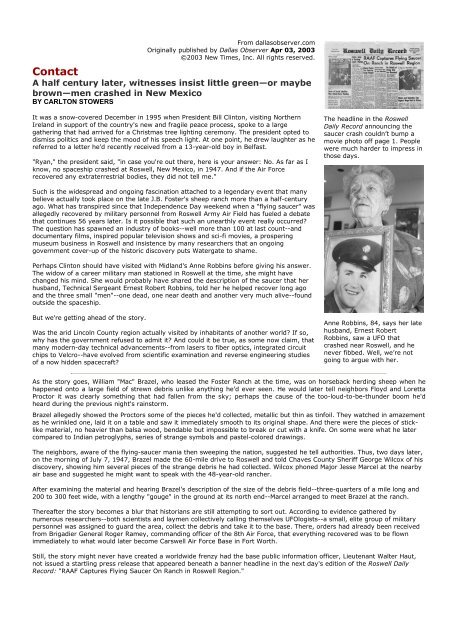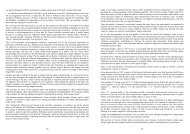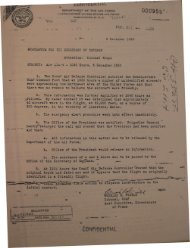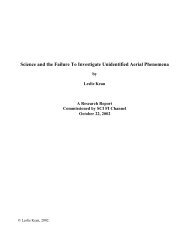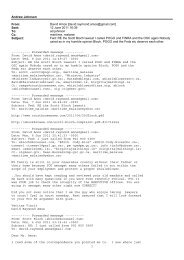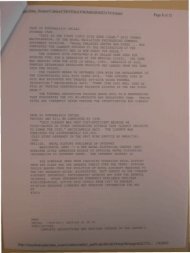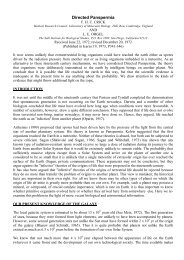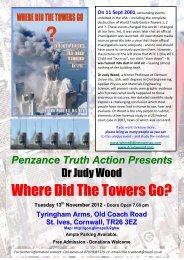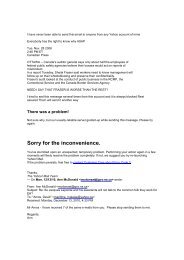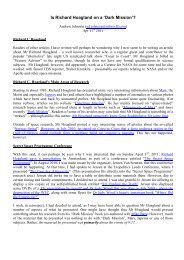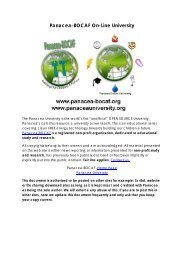Latest Roswell Witnesses - CheckTheEvidence.com
Latest Roswell Witnesses - CheckTheEvidence.com
Latest Roswell Witnesses - CheckTheEvidence.com
- No tags were found...
You also want an ePaper? Increase the reach of your titles
YUMPU automatically turns print PDFs into web optimized ePapers that Google loves.
From dallasobserver.<strong>com</strong>Originally published by Dallas Observer Apr 03, 2003©2003 New Times, Inc. All rights reserved.ContactA half century later, witnesses insist little green—or maybebrown—men crashed in New MexicoBY CARLTON STOWERSIt was a snow-covered December in 1995 when President Bill Clinton, visiting NorthernIreland in support of the country's new and fragile peace process, spoke to a largegathering that had arrived for a Christmas tree lighting ceremony. The president opted todismiss politics and keep the mood of his speech light. At one point, he drew laughter as hereferred to a letter he'd recently received from a 13-year-old boy in Belfast."Ryan," the president said, "in case you're out there, here is your answer: No. As far as Iknow, no spaceship crashed at <strong>Roswell</strong>, New Mexico, in 1947. And if the Air Forcerecovered any extraterrestrial bodies, they did not tell me."The headline in the <strong>Roswell</strong>Daily Record announcing thesaucer crash couldn’t bump amovie photo off page 1. Peoplewere much harder to impress inthose days.Such is the widespread and ongoing fascination attached to a legendary event that manybelieve actually took place on the late J.B. Foster's sheep ranch more than a half-centuryago. What has transpired since that Independence Day weekend when a "flying saucer" wasallegedly recovered by military personnel from <strong>Roswell</strong> Army Air Field has fueled a debatethat continues 56 years later. Is it possible that such an unearthly event really occurred?The question has spawned an industry of books--well more than 100 at last count--anddocumentary films, inspired popular television shows and sci-fi movies, a prosperingmuseum business in <strong>Roswell</strong> and insistence by many researchers that an ongoinggovernment cover-up of the historic discovery puts Watergate to shame.Perhaps Clinton should have visited with Midland's Anne Robbins before giving his answer.The widow of a career military man stationed in <strong>Roswell</strong> at the time, she might havechanged his mind. She would probably have shared the description of the saucer that herhusband, Technical Sergeant Ernest Robert Robbins, told her he helped recover long agoand the three small "men"--one dead, one near death and another very much alive--foundoutside the spaceship.But we're getting ahead of the story.Was the arid Lincoln County region actually visited by inhabitants of another world? If so,why has the government refused to admit it? And could it be true, as some now claim, thatmany modern-day technical advancements--from lasers to fiber optics, integrated circuitchips to Velcro--have evolved from scientific examination and reverse engineering studiesof a now hidden spacecraft?Anne Robbins, 84, says her latehusband, Ernest RobertRobbins, saw a UFO thatcrashed near <strong>Roswell</strong>, and henever fibbed. Well, we’re notgoing to argue with her.As the story goes, William "Mac" Brazel, who leased the Foster Ranch at the time, was on horseback herding sheep when hehappened onto a large field of strewn debris unlike anything he'd ever seen. He would later tell neighbors Floyd and LorettaProctor it was clearly something that had fallen from the sky; perhaps the cause of the too-loud-to-be-thunder boom he'dheard during the previous night's rainstorm.Brazel allegedly showed the Proctors some of the pieces he'd collected, metallic but thin as tinfoil. They watched in amazementas he wrinkled one, laid it on a table and saw it immediately smooth to its original shape. And there were the pieces of sticklikematerial, no heavier than balsa wood, bendable but impossible to break or cut with a knife. On some were what he later<strong>com</strong>pared to Indian petroglyphs, series of strange symbols and pastel-colored drawings.The neighbors, aware of the flying-saucer mania then sweeping the nation, suggested he tell authorities. Thus, two days later,on the morning of July 7, 1947, Brazel made the 60-mile drive to <strong>Roswell</strong> and told Chaves County Sheriff George Wilcox of hisdiscovery, showing him several pieces of the strange debris he had collected. Wilcox phoned Major Jesse Marcel at the nearbyair base and suggested he might want to speak with the 48-year-old rancher.After examining the material and hearing Brazel's description of the size of the debris field--three-quarters of a mile long and200 to 300 feet wide, with a lengthy "gouge" in the ground at its north end--Marcel arranged to meet Brazel at the ranch.Thereafter the story be<strong>com</strong>es a blur that historians are still attempting to sort out. According to evidence gathered bynumerous researchers--both scientists and laymen collectively calling themselves UFOlogists--a small, elite group of militarypersonnel was assigned to guard the area, collect the debris and take it to the base. There, orders had already been receivedfrom Brigadier General Roger Ramey, <strong>com</strong>manding officer of the 8th Air Force, that everything recovered was to be flownimmediately to what would later be<strong>com</strong>e Carswell Air Force Base in Fort Worth.Still, the story might never have created a worldwide frenzy had the base public information officer, Lieutenant Walter Haut,not issued a startling press release that appeared beneath a banner headline in the next day's edition of the <strong>Roswell</strong> DailyRecord: "RAAF Captures Flying Saucer On Ranch in <strong>Roswell</strong> Region."Haut's press release, ordered by Colonel William Blanchard, the base <strong>com</strong>manding officer, made it clear that something more
than pieces of scattered debris had been found. "The intelligence office of the 509th Bombardment group at <strong>Roswell</strong> Army AirField announced at noon today that the field has <strong>com</strong>e into possession of a flying saucer," it read. The release went on toexplain that "Major Marcel and a detail from his department went to the ranch and discovered the disc."Soon, calls were <strong>com</strong>ing to Haut from news agencies throughout the world.Now 80 and co-founder of the International UFO Museum and Research Center in <strong>Roswell</strong>, Haut says, "After meeting withColonel Blanchard in his office and getting the information for the press release, I wrote it and went to town around five thatafternoon to deliver it to the radio and newspaper people."That done, I went on home and was having dinner when people from all over the world started calling. Finally, about midnight,my wife, who was getting a little unhappy with the flood of calls, just took the phone off the hook and told me we were going tobed."Then, just as quickly as the excitement had developed, it came to a crashing end with a Fort Worth news conference called byGeneral Ramey the following day. Despite claims by Marcel to investigators years later that the amount of debris loaded ontothe B-29 that was flown from <strong>Roswell</strong> to Fort Worth "was enormous," half filling the huge plane, reporters and photographerswho gathered in the general's office were shown only tattered remnants of a weather balloon and given a smiling apology forall the unwarranted excitement. In attendance was Major Marcel, admitting he had been mistaken.The official version of the <strong>Roswell</strong> incident thus became that a military weather balloon launched to detect wind velocity anddirection at high altitudes had <strong>com</strong>e crashing down on Foster Ranch. End of story. The headline in the next day's <strong>Roswell</strong> paperwas as definitive but not nearly as exciting as the one published the day before: "Gen. Ramey Empties <strong>Roswell</strong> Saucer." In amore innocent and patriotic time, with World War II still fresh in the public's mind and trust in the government blindlyindisputable, the explanation was good enough. For most. For a time.Anne Robbins, who until now has never spoken publicly on the matter, says what her late husband saw 56 years ago washardly a downed weather balloon.Seated in a meeting room at the newly opened Odessa Meteor Crater Museum, the 84-year-old Robbins clearly recalls a Julynight when her husband received a call to report to the base. She would not see or hear from him for 18 hours. And when shedid, he told her bits and pieces of a bizarre story that has puzzled her for a lifetime."We had been to a dinner party at the NCO [non-<strong>com</strong>missioned officers] club on the base," she says, "and didn't get home until10:30 or 11. We'd already gone to bed but weren't yet asleep when everything outside lit up like it was daylight. It was likethat for what seemed like several minutes, and we both assumed that it was probably helicopters from the base withsearchlights on."Soon thereafter, the phone call came to their home and her husband told her he had to report to the base."I just assumed that there had been a plane crash somewhere nearby," she says. "But I couldn't figure why my husband, asheet-metal man who repaired planes, was called in."She was even more puzzled when he returned home the following evening, his uniform wrinkled and damp. "I asked him whathad happened to him, why he was so wet, and he told me he'd had to go through the decontamination tank at the base. Iasked, 'In your clothes?' and he said, 'They were what I was wearing when I was out there.'"Still assuming that he'd been called to the site of a plane crash, she quizzed him further. "He told me, 'Well, I guess you mightas well know; it's going to be in the papers. A UFO crashed outside of <strong>Roswell</strong>.'"Her response? "I told him he was crazy.""No," Sergeant Robbins replied, "I'm not." Then he showered and went to bed."I don't remember him being particularly shocked or very emotional about it," she says. "In fact, he seemed cool as acucumber. He just made it clear to me that he wasn't going to talk about it."The following morning she continued to press for details. "I asked him again if it was really true and he said, yes, it was." Whenshe asked what the UFO looked like, he explained that "if you took two saucers and put them together, that's what it lookedlike." On the top layer, he told her, there were oblong-shaped windows all the way around the craft. And, no, he said, he hadnot looked inside the crashed ship."I asked him if there was anybody on it. He said, 'I can tell you this much: There were three people. One was dead and twowere still alive. I can't tell you anything more.'"It was not until several days later that Sergeant Robbins finally agreed to drive his wife out to the crash site. By then, all debrishad been cleared away and neither a spaceship nor signs of military personnel was evident. "He didn't say much of anythinguntil we got to a place where there was this big burned spot, a perfect circle so black that it was shiny. No normal fire couldhave made something like that." It was, she says, as if the sand had been melted and turned into a sheet of black glass."This," Sergeant Robbins said, "is where I was for 18 hours.""On the drive home," she says, "I asked him what happened to the spaceship, what happened to the people who were on it.Her husband's reply: "I can't tell you that; don't ask me any more."- 2 -
It was the last time her husband spoke of "the <strong>Roswell</strong> incident" until long after he'd retired from the service. Until his death ofa heart attack two years ago, he never told his wife who was with him that night or what role he had played.Following his retirement from the Air Force in 1961, they moved to Saginaw, near Fort Worth, and he worked first for GeneralDynamics, then LTV, as an aircraft repairman."It was years later, when our kids were in high school, that our son Ronald was working on some kind of report on unidentifiedflying objects and asked his father to tell him about what happened back in <strong>Roswell</strong>. He didn't say much, basically just whathe'd told me years earlier," she says."But you know how kids are. Ronald kept asking questions, like what the men found at the crash looked like. Finally, Papa [asshe referred to her husband throughout their 57-year marriage] got a pencil and drew this pear-shaped head with large blackeyes. Their skin, he said, was brown and they had no nose, no mouth."When Ronald asked him what their bodies looked like, all he would say was, 'Son, you don't want to know about that.'"The Robbins' son, now living in Arizona, could not be reached by the Dallas Observer. "He wouldn't talk to you about it,anyway," his mother insists. Neither of her children, in fact, has ever spoken publicly of their father's alleged involvement inthe <strong>Roswell</strong> incident. "Barbara, my daughter, tells me, 'Daddy's dead, don't bring it up.'""All I remember," says Barbara Wattlington, "was Dad saying he was stationed in <strong>Roswell</strong> and that a UFO crashed there."The last time Anne Robbins remembers any conversation about the matter was a few years before her husband's death inJanuary 2000, when they sat in their Saginaw living room one evening, watching television. A show whose title she can't recallwas on, re-creating the <strong>Roswell</strong> event and posing the question of whether it was an ageless hoax or the well-hidden truth. "Iasked him, 'Was it a hoax?' and all he said was, 'It's the truth. It did land.'"I asked him, 'Well, if it did, where is it?' He again said he couldn't tell me that."Her husband, she says, was never one to embellish or lie; neither prankster nor teller of tall tales. "He was a good, Christianman. He loved the military and his country and never spoke bad about either." No, she says, he would never have made upsuch a story. Nor, if ordered not to, would he have ever talked of matters he was told to keep secret. "That's just the way hewas," she says. "On the day he died, the last thing he told me was that he wanted me to promise to fly the flag in front of ourhouse until I drew my last breath."Though she insists she has never researched the numerous theories of the <strong>Roswell</strong> crash presented in the countless books ordocumentaries, she does admit that she has lingering questions she hopes will one day be answered. "That UFO they founddidn't just fly away," she says. "So where is it? And what happened to the people on it? I still say the Air Force knows whathappened. Someday, I hope, we might find out the truth."Two years ago she did get an answer to one question that had long bothered her. "I could never figure out why an airplanerepairman would be called out in the middle of the night to participate in the investigation of a crashed UFO," she says. Onlyafter filing her husband's death certificate with military officials in Washington, D.C., did she learn that he had intelligenceclearance during his <strong>Roswell</strong> tenure.Still, if Anne Robbins had embarked on a thorough study of the massive collection of research done on the fabled <strong>Roswell</strong>crash, she would not find her husband's name among any of the "witnesses" who have <strong>com</strong>e forward over the years. Yet thesketchy details he gave her generally mesh with most of the reconstructed stories found in the ever-growing volume ofliterature devoted to the crash investigation.It was not until 1978, three decades after the brief flurry of interest in the crashed UFO-turned-weather balloon, that JesseMarcel, the intelligence officer who had been at the center of the original event, came forward with a story far different fromthe one told attendees of the Carswell news conference.The material flown from <strong>Roswell</strong> to Fort Worth was never actually shown to the media, he confided to nuclear physicist-turned-UFO investigator Stanton Friedman. It was, instead, quietly delivered to a research laboratory at Wright-Patterson Army AirForce Base in Dayton, Ohio.Marcel's revised recollections of the 1947 event, along with those of others who had finally chosen to speak out, ultimatelyappeared in the 1980 book The <strong>Roswell</strong> Incident co-authored by William Moore and Charles Berlitz, setting off a renewedappetite for information. Soon it came in a virtual flood of eyewitness reports and recollections of family members who, likeAnne Robbins, began revealing secrets they had long been told to keep. The <strong>Roswell</strong> story exploded into the best-knownalleged UFO encounter in history.According to the story now told by researchers, ranging from the serious to those writing for the supermarket tabloids, thingsfar more bizarre had already occurred before Mac Brazel discovered the debris field. Those who have written about the event inthe years since suggest a fascinating sequence of events that occurred in the early days of that July:For several nights, <strong>Roswell</strong> residents had reportedly seen a strange flying object in the night sky. Though no one would knowabout it for 30 years, two Franciscan Catholic nuns, working at the local St. Mary's Hospital, even made notations in theirdiaries that at some time after 11 p.m. on July 4, 1947, they had seen a large flash in the night sky, assuming that it was aplane in distress.What <strong>Roswell</strong> AAF radar operator Frank Kaufmann said he saw was even more remarkable. On that same evening he was- 3 -
tracking the strange movement of a mysterious object flying at an incredible rate of speed. Suddenly it began losing altitudeand the blip on the radar screen enlarged into a large starburst pattern that suggested an explosion had occurred. It wasestimated that the event had occurred somewhere within a 100-mile range northwest of the base and a search team wasimmediately dispatched.Jim Ragsdale would later tell of seeing what occurred at much closer range. He and his girlfriend, on a rock-hunting trip, wereparked at a secluded campsite on what was known as Boy Scout Mountain, when they saw a flash, then heard a thunderingexplosion. Within seconds, Ragsdale would later tell researchers, the UFO skipped along the desert not far away, then came torest at the base of a nearby bluff. Grabbing flashlights, he and his girlfriend made their way to the crash site where he says asaucer-shaped vehicle had <strong>com</strong>e to rest. Not only did he eventually tell of seeing the crashed UFO but the bodies of several"childlike" passengers. After picking up a few pieces of debris from the wreckage, the young couple decided to return to theirpickup and wait until daylight for a better look.When they did return, Ragsdale later wrote in a sworn affidavit, they saw a military convoy arriving and briefly hid to watchbefore deciding to leave (taking with them pieces of the debris he says they later showed to numerous people in a nearby bar).Had they remained, the story goes, they would have eventually seen the UFO hoisted by crane onto the bed of a flatbed truckand the bodies placed in another military vehicle that was ordered to quickly return to the <strong>Roswell</strong> base hospital.The actual crash site, then, had been swept clear by military personnel hours before Mac Brazel rode up on the debris fieldseveral miles away. Later, researchers would assume that the craft had apparently first hit on the Foster Ranch, sliding alongfor a distance, then had briefly managed to be<strong>com</strong>e airborne again before crashing.If the material found in such books as The Truth About the UFO Crash at <strong>Roswell</strong>, Crash at Corona, Beyond <strong>Roswell</strong>, and AlienContact: Top Secret UFO Files Revealed is to be believed, the interplanetary visit was, in many respects, a pretty poorly keptsecret from the get-go. The only problem is, it was years before folks would talk about it.Yet, before their deaths, numerous people or their descendants recounted anecdotes of involvement in and observations madeduring the strange event.For instance, long after his father's death in 1986, Dr. Jesse Marcel Jr., 66, still tells of Major Marcel stopping by the house onan early July morning in 1947 to show him and his mother pieces of the crash debris that he had collected. Eleven years old atthe time, Dr. Marcel recalled his father bringing pieces of the downed "flying disc" from his car and spreading them on thekitchen floor. He recalled handling the aluminum foil-like material and seeing the unusual symbols on what he said looked likepieces of black plastic.Now living in Helena, Montana, Dr. Marcel says the most remarkable memory he has of the pieces his father showed him wasof the geometric-like symbols on some of them. "I've always referred to them as I-beams," he says, "though I have no ideawhat they really were."My father was very excited about what they had found," Dr. Marcel says, "and since our house was on the way to the base, hejust decided to stop by and show it to us. Then he took it on out to the base."Major Marcel's excitement, however, was quickly muted. "The next day," his son remembers, "he sat down with my mother andme and told us we were never to talk about what he'd shown us. He said, 'Don't think about it. It didn't happen.'"Today, Dr. Marcel remains convinced that the material his father showed him came from another world.Then there is the story that the late Sergeant Melvin Brown waited until 1970 to tell his daughters. Retired and living inEngland, he said that he had been at the crash site in '47 and was assigned to guard the alien bodies as they were beingtransported back to the base. Though sworn to secrecy, he finally told of being ordered to ride in an "ice-filled truck" that wasto take the bodies to a hangar. On the trip, Brown told his daughter Beverly Bean, he had lifted a tarp and seen "two, possiblythree bodies."And there were others who would eventually tell of seeing the alien bodies, including <strong>Roswell</strong> AAF radar operator Kaufmann,who would later claim to have been among those ordered to the crash site where, he later told researchers Don Schmitt andKevin Randle, authors of UFO Crash at <strong>Roswell</strong>, he saw five small aliens, all clearly dead.Oliver "Pappy" Henderson, a World War II pilot assigned to the <strong>Roswell</strong> Army Air Field at the time, allegedly told friend Dr. JohnKromschroeder during a fishing trip in 1978 that he had flown much of the debris--and the bodies of what he only described as"those little guys"--to Wright-Patterson aboard a C-47. Shortly before his death in 1986, Henderson also told the story to hiswife.In his book, The Day After <strong>Roswell</strong>, retired Colonel Philip Corso is far more graphic as he writes of a night a sentry urged him toenter an off-limits Wright-Patterson building where more than 30 crates of Henderson's cargo had been stacked against a wall,draped by large tarps. When the sentry pointed to a particular crate he'd already looked in--in clear violation of orders he'dbeen given --Corso opened it and shined a flashlight on its contents."My stomach rolled right up into my throat, and I almost became sick," he writes. "[Inside] was a coffin, but not like any coffinI'd ever seen before. The contents, enclosed in a thick glass container, were submerged in a thick light blue liquid..."At first I thought it was a dead child they were shipping somewhere. But it was no child. It was a 4-foot human-shaped figurewith arms, bizarre-looking four-fingered hands--I didn't see a thumb--thin legs and feet and an oversized incandescent lightbulb-shaped head...the eyesockets were oversized and almond-shaped..."- 4 -
Perhaps the most provocative story came not from a member of the military but, instead, a <strong>Roswell</strong> mortician named GlennDennis. Twenty-two at the time and director of the local Ballard Funeral Home, he told of receiving a telephone call from thebase on the afternoon of July 5, 1947, asking if he could provide several "small," hermetically sealed caskets. Thirty minuteslater, he would eventually recall to numerous researchers and journalists, he answered a second call, this time with a series ofquestions about the techniques of embalming and preserving dead bodies and if such processes would alter the chemicalcontents of blood and tissue. Finally, he reported, he was asked what happened to body tissue after it had been exposed to theelements.Curious, Dennis says he asked if there was something he could help with and was told the questions were only "for futurereference."Later that day, Dennis recalled, he had driven an injured airman to the base infirmary. While there, he noticed an unusualamount of activity at the base hospital. Encountering a nurse named Naomi Selff in the hallway, she was clearly surprised tosee him and warned that "he wasn't supposed to be there and had better leave immediately."Minutes later, his story went, he was escorted by two military police all the way back to the funeral home.It was not until the following day that he learned what had been happening. He phoned nurse Selff and they agreed to meet forlunch. Obviously distraught, she told him of seeing three small bodies, two of which were badly mutilated, and of being orderedby attending military doctors to take notes while they conducted their examinations. The stench of the corpses, she allegedlytold him, had been almost more than she could stand. Before he returned her to her barrack, Dennis recalled, she drewsketches of the aliens on a prescription pad and gave them to him with a warning that he should "show them to no one."That, the mortician says, was the last time he ever saw her. After numerous unsuccessful attempts to reach her by phone, helearned several days later that she had suddenly been reassigned to duty in England. Shortly thereafter, he was told that shehad died there in a plane crash.Co-founder of the <strong>Roswell</strong> museum with Haut, Dennis is currently in poor health and was unable to speak with the Observerabout his well-chronicled story.But for every true believer there are skeptics, researchers who have picked away at the colorful, unimaginable stories in searchof their flaws. And they have found many. Among the debunkers is Kal K. Korff, author of The <strong>Roswell</strong> UFO Crash: What TheyDon't Want You to Know. He not only questions why so many waited so long to <strong>com</strong>e forward with the stories but points outthat many of them are, like that of Anne Robbins, hand-me-down tales allegedly kept secret until the firsthand witnesses weredead.Korff's questions are valid: Why have some of the reported witness accounts described the downed UFO as "saucer-shaped"while others remember it being "triangular-shaped with small wings?" While most who claimed to have seen the bodies recallthere being three, others say they saw as many as five. Some say all were dead, others that one or more was still alive.Descriptions of the color of the small bodies range from gray to brown. How could mortician Haut have "lost" something asimportant as the drawings he says his nurse friend made and gave to him? And if, in fact, so many civilians collected pieces ofthe strange-looking debris, why has not a single piece of it ever surfaced?It was not until 1994 that an Air Force investigation into the aging <strong>Roswell</strong> affair resulted in an announcement that the materialfound on the Foster Ranch was, in fact, a crashed high-altitude test balloon that would eventually be able to monitor Sovietnuclear testing. Actually a chain of radar-equipped balloons, it had been launched on July 4, 1947, and was tracked to within17 miles of the Foster Ranch before disappearing.When the explanation failed to satisfy many "believers," the Air Force released yet another report in '97, this one titled The<strong>Roswell</strong> Report--Case Closed, in which it attempted to answer the lingering question of the "bodies" allegedly seen at the crashsite. What the so-called witnesses had seen, according to the report, were nothing more than crash-test dummies that werepart of a military experiment in parachute and ejector seat designs.That, too, failed to satisfy those determined that the governmental cover-up continued. Such tests, several military researchersargued, had not even begun until the mid-'50s."The reason the interest in the <strong>Roswell</strong> case remains and, in fact, seems to grow," says Mark Rodeghier, scientific director ofthe Chicago-based Center for UFO Studies, "is the fact the government has never given a reasonable explanation of whatoccurred that summer of 1947."Thus it continues, an unexplained event that has turned into an industry. What happened or didn't happen 56 years ago haslured 1.3 million to the International UFO Museum and Research Center since it opened in 1992. A guided tour of the desolate"crash site" is now available. Then, there was the long-lost film of the "autopsy" of one of the <strong>Roswell</strong> aliens that was shown ontelevision worldwide before being discounted as fake, and a stream of new books and articles that continues to flow. Clearly,the public loves the mystery. According to a recent poll, a large percentage of the U.S. population continues to believesomething unworldly occurred that July on the Foster Ranch.Walter Haut, one of the few major figures in the long-ago story still living, is among them. "I'm sure," he says, "that over theyears much of the story has been exaggerated. But, yes, I believe that something happened out there in 1947." And he's notspeaking of a weather balloon crash.- 5 -


